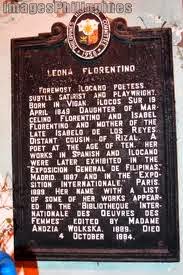"The mother of Philippine women's literature" and the "bridge from oral to literary tradition."
Dr Abe V Rotor
Original plaza and monument of the greatest Filipina literary icon in Vigan at the gateway to the future UNESCO Heritage City in the 1950's
Leona Florentino's monument today with new historical
marker has lost much of its original solemnity.
Leona Florentino is one of the four pillars of Philippine literature, with Jose Rizal, Balagtas and Severino Reyes (Lola Basyang). These four pillars have provided the foundation of Philippine literature that links it with the literature of the world. The four pillars steered the course of Philippine Literature into the postmodern era, which is the theme of a new textbook, Philippine Literature Today (C&E Publishing Co.,) written jointly by the author and Dr Kristine Molina-Doria.
Philippine Literature Today featuring the four pillars of Philippine Literature:
Jose Rizal, Francisco Balagtas, Severino Reyes (Lola Basyang) and Leona Florentino the doyen of Philippine poetry in Spanish, Ilokano (Samtoy), and other regional dialects.
--------------------------------------------------------------
Leona Florentino (19 April 1849 - 4 October 1884) was a Filipino poet in the Spanish and Ilocano languages. She is considered as the "mother of Philippine women's literature" and the "bridge from oral to literary tradition".
Born to a wealthy and prominent family in Vigan, Ilocos Sur, Florentino began to write her first verses in Ilocano at a young age. Despite her potential, she was not allowed to receive a university education because of her gender. Florentino was instead tutored by her mother, and then a series of private teachers. An educated Ilocano priest taught her advanced Spanish and encouraged her to develop her voice in poetry.
Florentino married a politician named Elias de los Reyes at the age of 14. They had five children together. Their son Isabelo de los Reyes later became a Filipino writer, activist and senator. Due to the feminist nature of her writings, Florentino was shunned by her husband and son; she lived alone in exile and separately from her family. She died at the age of 35.
Her lyrical poetry in Spanish, and especially that in Ilocano, gained attention in various international forums in Spain, Paris and St. Louis, Missouri. Her literary contributions - particularly 22 preserved poems - were recognized when she was included in the Encyclopedia Internationale des Oeuvres des Femmes (International Encyclopedia of Women’s Works) in 1889. She is believed to be the first Filipina to receive this international recognition, an homage that occurred after her death at a young age.
--------------------------------------
Blasted Hopes
What gladness and what joy
are endowed to one who is loved
for truly there is one to share
all his sufferings and his pain.
My fate is dim, my stars so low
perhaps nothing to it can compare,
for truly I do not doubt
for presently I suffer so.
For even I did love,
the beauty whom I desired
never do I fully realize
that I am worthy of her.
Shall I curse the hour
when first I saw the light of day
would it not have been better a thousand times
I had died when I was born.
Would I want to explain
but my tongue remains powerless
for now do I clearly see
to be spurned is my lot.
But would it be my greatest joy
to know that it is you I love,
for to you do I vow and a promise I make
it’s you alone for whom I would lay my life.
Mga Tula ni Leona Florentino
(Salin mula sa Samtoy ni Josie Clausen;
isinaayos ni Ruth Elynia S. Mabanglo)
ANG PAGPAPAALAM(Panagpakada)
O Mutya ng pag-ibig, ako’y dinggin
Nasadlak sa hirap at dumaraing;
O Puso, maanong amutan ng tingin,
Ang kaawa-awa’y iyong pansinin.
MGA HINANAKIT NG ISANG NABIGO
(As-Asug Ti Maysa A Napaay)
*Original poems in Ilokano
PANAGPAKADA
Timudem man! O Imnas ni ayat,
ti un-unnoy toy seknan ni rigat;
imatangam, O puso ket imutektekannak
anusem a paliiwen toy daksanggasat.
Daksanggasat konak a ta maipusay
toy naldaang unay a bangkay;
ngem ni lagip dinto met bumalakday,
agnanayonto laeng a sitatarabay.
Kas panagpakada dagitoy nga innak baliksen,
ta toy bagik maipanaw kadagita taeng;
taeng ni ragsak, liwliwa nga innak lak-amen,
dinto met mapunas nga innak pampanunoten.
Silaladingit toy puso nga agpakada,
Adios laing, napusaksak nga asusena;
Iti sayamusom ti barukongko ipenpennaka,
tapno dinto maumag ti agdaplay a banglona.
Siaaddaakto laeng, ti taeng ni alinaay,
ta ditoy panunot salemseman ni tarumpingay;
tarabayennakto ni napait a liday,
ket isunto kaniak ti mangay-ay-ay.
Dios ti kumuyog, O napnuan sayaksak,
nga esmanto dagiti agay-ayat;
Dios ti kumuyog, salimetmetmo mangalasag,
ta tapno dayta sudim, taknengmo ti di marakrak.
AS-ASUG TI MAYSA A NAPAAY Nasnebanak ti nasaem a sasainnek, ay ayat!
ta diman la agtanak ti lak-amen a tuok ken rigat;
isuna kadin isunan; ala isunan yantangay detoy biag,
diak duaduaenen a suminan itoy bagik a daksanggasat.
Ay, ayat, ayaunayen ti sanaang
ni patay sumken nakalkaldaang
ta iti maysa nga agayat a dida pagayatan,
nakasaksakit nakem a maimatangan.
Narangas dagiti laingmo ken sayaksakmo naulpit,
nadawel, kitaem man toy silaladingit;
ta naallilaw man dagitoy matak idi a buybuyaek,
ta iti inanama ken talek isuda kaniak ti namatalged.
Ngem eppes man dagidi nga inanama,
ta diak impapan a kastoy ti tungpalna,
tungpal tanem ket itan ti nagbanaganna,
datoy bagik ta isu ti kaikarianna.
RUKRUKNOY*
Dimteng itay, kakabsatko a kaingungotak
ti aldaw a tinudingan ti Dios a puon ti imbag
nga inkay panagassawa panagkaysa siaayat
iti natan-ok a Sakramento nga inkay inawat.
Natungpal itayen ti tinartarigagayanyo
a panagkallaysa dagiti puspusoyo;
ti napateg a bandisionna inawatyo
iti Santa Iglesia nga inatayo.
Itan ' ti kababalinto panagbiagyo
nupay dua maymaysa ti bagiyo
a mangipakita mangipatalged kadakayo
ti rebbengyo a panagayan-ayat panagdungngo-dungngo.
Ti kawar a namagsinggalot kadagiti pusoyo
dinto mawarwaren ingganat' tungpal biagyo
rosasto laeng ti arigna no tungpalenyo
ti panagayan-ayat nga inkariyo.
Anansata no ragsak ti maysa ragsakyo a dua
no rigat ti maysa, rigatyo met a dua
adaywanyo ti ilem ken panagduadua
a mangirurumen ti sudi ti panagtinnalek ti agassawa.
Ala Severino awatem ti kapatgan a saniata
nga ited ti Apotayo aDios nga isagut kenka
salimetmetam kas napateg unay a perla
ita nagmumotan ti pusom ti concha a pakaidulinanna.
Isu dayta daydi sabong nga inka nakita
ti sidong asi ken dungngo ti maysa nga ina
a naiduma ti lasbang ken rangpayana
iti panagdungngo; panag tarakenna.
Nupay kasano ti sakit ti nakemna
amangisina, mangyadayo iti dennana
maipapilit itayen ~ purosenna
a yawat tapno sika pay met ti manapaya.
Tapno di rralaylay ti rangpayana
ti ayat ken dungngom dikanto isina
ta isunto ti kas linnaaw a pagbiaganna
ken mangted ti nakaay-ayat a lasbangna.
Ti nadungngo a panangtaripatom kenkuana
isunto ti kas balsamo a mangserra
iti sugat a gapuanan ti pannakaisinana
kadagiti ima a nakasapsapuyotanna.
Ket sika kaingungotko a Vicenta
ti sudi ken dalusna inka ipakita
ti panagayatmo ita pinilim nga asawa
a nangyawatam ta pusom ken ima.
Anansata amin a panagtignaymo inka ipakita
ti tarigagaymo nga agserbi kenkuana;
ammuem amin a pagayayatanna
isu ti aramidem uray dina ibaga kenka.
No ti Apotayo aDios ta ikkannakayto
ti bunga ti panagassawayo
ipakitamto ti dakkel a salukagmo
iti pannakaaywanda pannakasursuro.
Panunotem ngaisuda ti kapatgan a saniata
a mabalin nga iparabur ti Dios kenka
a ragsak ken liwliwam ditoy rabaw ti daga
n~a ingganat' biagyo sumina.
No ubingda pay a maladaga
agawaamton nga imaldit iti pusoda
ti panagayat ken panagbutengda
iti Apotayo a Dios a namarsua kadakuada.
Amin met a tao a kadendennam
. nang runa dagiti nakaikamangam
naragsak a rupa ti ipakitam
agraemka ket inka ida padayawan.
Ket tapno matungpalmo ken masarkedam
amin dagitoy a pagrebbengan
ti Apotayo aDios ti inka pagdawatan
ti tulong ti grasiana a nadiosan.
Mayarig kama ti panagbiagyo nga agassawa
kada San Jose ken ni Blrhen Maria
ti dakkel nga urnos ken talnada
ken nasam-it unay ngaayan-ayatda.
Kas koma agayus a maysa a karayan
ti litnaw ti danumna a pagsarmingan
di koma mariribok ken mapitakan.
kadagiti rigat ditoy daga a pagluluaan.
Jti kamaudiananna dawatek iti Dios nga Apotayo
nga ikkannakay' ti nanam-ay a panagbiagyo,
dakkel ken saan a marakrak nga urnosyo
ingganat' patay ti magtenganyo.
Agawaanyo nga iburik iti uneg tl puspusoyo
day toy a balakad nga itedko kadakayo
napateg a gameng nga idatonko
itoy nagasat unay aldaw ti panagbodayo.
(Insagut ni Leona Florentino daytoy a daniw
kadagiti kakanakanna a Severino ken Vicenta.
iti panagkallaysa dagitoy idiay Vigan idi
Mayo 9, 1877.)
Isabelo de los Reyes, Sr. y Florentino
- Following the footsteps of his illustrious mother
Isabelo de los Reyes, Sr. y Florentino, also known as Don Belong, was a prominent Filipino politician, writer and labor activist in the 19th and 20th centuries. Wikipedia
Born: July 7, 1864, Vigan
Died: October 10, 1938, Manila
Parents: Leona Florentino, Elias de los Reyes
Education: University of Santo Tomas, Colegio de San Juan de Letran
Isabelo de los Reyes, Sr. y Florentino, also known as Don Belong (July 7, 1864 – October 10, 1938), was a prominent Filipino politician, writer and labor activist in the 19th and 20th centuries. He was the original founder of the Aglipayan Church, an independent Christian Protestant church in the catholic tradition. Due to his widespread Anti-Catholic writings and activism with labor unions, he is sometimes dubbed as the "Father of Filipino Socialism". Pope Leo XIII formally excommunicated Reyes in 1903 as a schismatic apostate.
As a young man, Reyes followed his mother's footsteps by initially turning to writing as a career; he won a prize at the age of 23 for his first written book. He later became a journalist, editor, and publisher in Manila, and was imprisoned in 1897 for revolutionary activities. He was deported to the Kingdom of Spain, where he was jailed for his activities until 1898. While living and working in Madrid, he was influenced by the writings of European socialists and Marxists.
Returning to the Philippines in 1901, Reyes founded the first labor union in the country. He also was active in seeking independence from the United States. After serving in the Philippine Senate in the 1920s, he settled into private life and religious writing. He had a total of 27 children with three successive wives; he survived all his wives and 12 of his children. (Wikipedia)


















+A.jpg)






.jpg)








